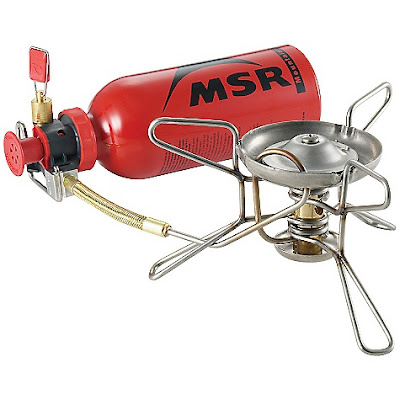Although I cannot compete with Brian’s pinball repair, I do have some of my own that I should post one of these days. However, since I’m too busy playing my Night Rider it’ll be a rainy day when I do post something about it.
Instead I’d like to offer a beginners guide to lighting an MSR Whisperlite liquid gas stove. For those of you who know me, yes I have all of my fingers and toes but an appropriate quote would be from Adam Savage “Am I missing an eyebrow?”
Back in the 20th century, when I was a boy scout, I recall going on back-packing trips and someone always had a funny looking miniature stove with a bottle and a pump. I knew that the pump was used to pressurize a fuel that was in the bottle and then burned, what I didn’t know was how or why they worked.
REI had a big labor day sale. One of the things that was on sale was a liquid gas stove. I figured it was about time that I step-up and get a real backpacking stove versus the coleman LP gas stove [that I stole from my parents power outtage supply kit]. Most of the liquid fuel stoves use a variety of white gas (also known as Naphtha), diesel, unleaded, alcohol, or oil but they are about twice as expensive. A little research shows that the aperture of the fuel areator jet is larger for the more viscus fuels. MSR states that in a pinch unleaded fuel could be used with the Whisperlite but it will require more cleaning.
So, There I was sitting outside my apartment with the stove assembled, filled with fuel, and pressurized. I’m reading the manual (this way Brian won’t say did you RTFM?) and following each instruction very carefully. The manual says to open the fuel valve 1.5 times to fill the ‘primer pan.’ The fuel that is in the primer pan is then lit. Well, this step is much easier said than done. After several failed attempts to ‘fill’ the primer cup I finally let the valve stay open for a while. Eventually I saw a nice little puddle of gas in the primer pan. OK, I’m ready to light.
The reason the primer pan is filled with fuel is to get the metal and the fuel line hot. This stove uses a what EE’s call a feedback loop. Heat from the stove pre-heats and vaporizes the fuel in the fuel line which is then pressurized to spray out of the aerator jet and into flame ring. It’s a bit odd to think that you have to heat the fuel line to get it to work.
I have a lighter in one hand and the stove in the other. Pay no attention to the fact that the air was perfectly still, not a single breeze in sight, nor that I had been fiddling with the fuel for 10 or 15 minutes prior to this. Funny thing about fuel vapors, they are much heavier than air and tend to be invisible until some sort of ignition system is used.
My thumb rolls down the BIC roller and the flint makes a marvelous spark which catches the lighters gas afire. I bring the lighter close to the primer pan and in an instant it lights up. A brillant flame that only the crew aboard the international space station could enjoy engulfed the patio which included the sage and lavender plants and moi. I jumped for cover – which I realized was futile as everywhere I looked was glowing.
A few seconds later and everything seemed to put itself out. Now I had to contend with the fireball that is now my stove. I followed the instruction to leave the valve open a little while the primer cup was burning, but I’d have to say that it’s much safer and easer to just turn the fuel off until the primer cup has burned all the fuel up. If the stove is hot, it will easily re-light.
The next day I learned from a friend at work that the best thing to do is to carry fire paste or a small squeeze bottle of rubbing alcohol. That night I tried rubbing alcohol. It was much easier to use and it didn’t leave any soot residue on the stove like the white gas.
The best way that I have found to light the Whisperlite is to fill the primer cup with alcohol, light it, wait for the flames to go out or most of the way out, and then light the fire rings like a normal stove.
Leave a Reply